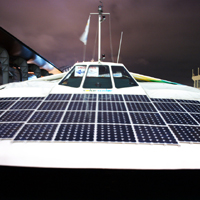With the Sun, with the Air and with the Water: Urban Mobility when the Oil will End
Abstract
The article, starting with the forecasts of the near depletion of the main energy source that allows the development of all human activities and emphasizing the strict dependence of urban and metropolitan systems on fossil fuels, shows an overview of the major innovations developed by technology in the specific field of urban car-based mobility.The entire discussion is developed considering the condition of energy mono-dependence produced by the total energy reference to the fossil fuels.
In particular, we consider the global data of energy consumption and similarly those related to mining activities.
Above all, a specific study is presented on the theory of the U.S. geologist Hubbert who developed a model to assess the mining potential of a deposit in relation to the so-called conventional oil.
The curve describes a “bell-shaped” trend of the estimated amount of recoverable oil, four different phases can be distinguished, the last of which is characterized by the final exhaustion of oil resources. Unfortunately this phase seems to have already begun, but no consequent pressures for effective development of efficient alternative energy sources are observed.
The article proposes an energy reversal based essentially on three factors: technological innovation, the recovery and promotion of social capital (especially in cities), the start of market structures which, in observance of the necessary profit, put sustainability (and not growth) at the base of their development processes. The research and technological development may, in the near future, allow to use efficiently sources of renewable energy.
At the same time, innovation can enable the development of new engines that use atypical propellants such as: sun, air or water. Technological innovation is the greatest hope for a possible solution to the energy problem, particularly with regard to physical mobility. The technology, however, if used incorrectly, acts as an accelerator and entropic transformer further compromising the conditions of the planet.
The final section describes the key technologies for vehicles based on propellant alternative to gasoline, which are, at present, already available for the market and could represent one of “systems” to solve the near depletion of the fossil resource.
The new forms of zero-emission fuel, such as compressed air, hydrogen, electricity, etc. will be investigated through the description of the different ideas of vehicle whose feasibility is already extensively tested.
Downloads
References
Brundtland Report, (1987), ”Our common future”, Report of the World Commission on Environment and Development, (http://www.un-documents.net/wced-ocf.htm).
Fistola, R., (2011), «Crisi urbana e cristallizzazione del caos territoriale. Agente individualista vs capitale sociale», in Moccia F. D. (a cura di), Urbanistica e Politica, collana: Governo del Territorio e Progetto Urbano - Studi e Ricerche n.4, Edizioni Scientifiche Italiane, Napoli.
Fistola, R., (2008), “Softmobility/Cybermobility nuove funzioni urbane e mobilità digitale”, in TeMA, vol. 1, n. 3.
Friedman, T. L., (2009), Caldo, Piatto e Affollato. Come è oggi il mondo e come possiamo cambiarlo, Mondadori, Milano.
Illich, I., (2005), « Le genre vernaculaire», in Euvrès completes, p. 192, vol. 2, Fayard, Paris.
Latouche, S., (2008), Breve trattato sulla decrescita serena, p. 34, Bollati Boringhieri, Torino.
Legambiente, Mal’aria di città 2011, http://risorse.legambiente.it/docs/malaria11.0000002212.pdf
Putnam, D. R., (2004), Capitale sociale e individualismo. Crisi e rinascita della cultura civica in America, Il Mulino, Bologna.
http://www.desertecitaly.altervista.org/Il-progetto-Desertec.html
http://www.regione.piemonte.it/energia/images/stories/dwd/inevidenza/com_stampa.pdf
http://www.aircarfactories.com/

Copyright (c) 2014 Tema. Journal of Land Use, Mobility and Environment

This work is licensed under a Creative Commons Attribution 4.0 International License.
Authors who publish in this journal agree to the following:
1. Authors retain the rights to their work and give in to the journal the right of first publication of the work simultaneously licensed under a Creative Commons License - Attribution that allows others to share the work indicating the authorship and the initial publication in this journal.
2. Authors can adhere to other agreements of non-exclusive license for the distribution of the published version of the work (ex. To deposit it in an institutional repository or to publish it in a monography), provided to indicate that the document was first published in this journal.
3. Authors can distribute their work online (ex. In institutional repositories or in their website) prior to and during the submission process, as it can lead to productive exchanges and it can increase the quotations of the published work (See The Effect of Open Access)
